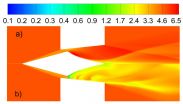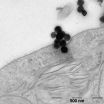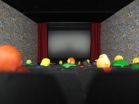(Press-News.org) Researchers at University of California, San Diego School of Medicine have validated an EEG test to study and treat schizophrenia. The findings, published in two separate studies, offer a clinical test that could be used to help diagnose persons at risk for developing mental illness later in life, as well as an approach for measuring the efficacies of different treatment options.
One of the studies, reported online Oct. 23 in Schizophrenia Research, shows that schizophrenia patients don't register subtle changes in reoccurring sounds as well as others and that this deficit can be measured by recording patterns of electrical brain activity obtained through electroencephalography (EEG).
The second, published online earlier this month in NeuroImage: Clinical, establishes a link between certain EEG tests and patients' cognitive and psychosocial impairments, suggesting that the EEG test could be used to objectively measure the severity of a patient's condition, and conversely that it might be possible to alleviate some of the symptoms of schizophrenia with specialized cognitive exercises designed to strengthen auditory processing.
"We are at the point where we can begin to bring simple EEG tests into the clinical setting to help patients," said Gregory Light, PhD, associate professor of psychiatry and a co-author on both studies. "We think it may be possible to train some patients' auditory circuits to function better. This could improve their quality of life, and possibly reduce common symptoms of schizophrenia such as hearing voices."
In experiments, UC San Diego scientists and colleagues with the Consortium on the Genetics of Schizophrenia monitored volunteers' electrical brain activity patterns as they listened to a sequence of beeps that occasionally included a discordant prolonged beep. The lengthier beeps were one-twentieth of a second longer than the standard beeps and occurred roughly 10 percent of the time.
A total of 1,790 people were tested at five sites nationwide as part of a National Institutes of Health-funded study to unravel the genetic basis of schizophrenia. Nine-hundred and sixty-six were schizophrenia patients; 824 were healthy control subjects.
The EEG data were analyzed for two auditory processing metrics. One is known as mismatch negativity (MMN). Measured in microvolts, MMN represents the difference between the brain's response to the expected stream of beeps and its response to the singular, different ping. The other, called P3a, is a measure of the electrical energy emitted by the brain as it automatically shifts attention to the longer beep.
People with schizophrenia were consistently shown to have reduced MMN and P3a relative to those without the disease, suggesting they had a muted ability to detect and direct their attention to the discordant beep.
In the second study, researchers showed that measures of MMN and P3a were associated with the severity of a patient's symptoms and their day-to-day real-world functioning.
Specifically, in a comparison of MMN and P3a measurements from 42 patients with schizophrenia and 47 non-psychiatric comparison subjects, scientists showed that differences in these auditory processing metrics accounted for approximately half of the variance in the severity of patients' symptoms and their ability to perform tasks necessary for real-world functioning.
The two studies further validate the ability to measure MMN and P3a with only one EEG electrode placed on the front of the scalp, meaning that the EEG testing can be conducted outside of academic research laboratories.
Researchers plan to use their studies' findings to try to improve the quality of life for patients at the Alpine Special Treatment Center, a mental health rehabilitation and long-term care facility in eastern San Diego County.
"Our goal is to see if we can help people improve their brain functioning by providing daily cognitive exercises that are designed to sharpen their sensory information processing," said Light, who is also associate director of the VISN-22 Mental Illness, Research, Education and Clinical Center (MIRECC) at the Veterans Affairs San Diego Healthcare System. "We will then use EEGs to see if we can identify markers that predict which patients are most likely to benefit from this form of treatment."
INFORMATION:
Funding for the study in Schizophrenia Research was provided, in part, by the National Institute of Mental Health (grant R01 MH065571) and Brain and Behavior Research Foundation.
Co-authors include: Neal R. Swerdlow, Michael L. Thomas, Tiffany A. Greenwood, Marlena Pela, Richard F. Sharp, Joyce Sprock, David L. Braff, UC San Diego; Monica E. Calkins, Raquel E. Gur, Ruben C. Gur and Bruce I. Turetsky, University of Pennsylvania; Keith H. Nuechterlein and Catherine A. Sugar, UCLA; Laura C. Lazzeroni, Stanford University; Michael F. Green, UCLA and VA Greater Los Angeles Healthcare System, Los Angeles; Allen D. Radant and Debby W. Tsuang, University of Washington and VA Puget Sound Health Care System, Seattle; Larry J. Seidman and William S. Stone, Harvard Medical School and Beth Israel Deaconess Medical Center, Boston; Larry J. Siever and Jeremy M. Silverman, The Mount Sinai School of Medicine and James J. Peters VA Medical Center, New York; Ming T. Tsuang, UC San Diego and Harvard Institute of Psychiatric Epidemiology and Genetics.
Funding for the study in NeuroImage: Clinical was provided, in part, by National Alliance for Research on Schizophrenia, Brain and Behavior Research Foundation, Department of Veteran Affairs, Veterans Medical Research Foundation and National Institute of Mental Health (grants MH079777, MH042228, MH065571, MH094151, MH093453, MH094320, UL1TR000100 and MH081944).
Co-authors on the study include: Anthony J. Rissling and Scott Makeig, UC San Diego; Makoto Miyakoshi, UC San Diego and Japan Society for the Promotion of Science; Catherine A. Sugar, UCLA and Greater Los Angeles VA Healthcare System; and David L. Braff, San Diego VA Medical Center and UC San Diego.
EEG test to help understand and treat schizophrenia
2014-10-29
ELSE PRESS RELEASES FROM THIS DATE:
Decades of research: Effectiveness of phone counseling for cancer patients still unknown
2014-10-29
Increasingly, cancer care respects the fact that a patient's body is only part of the system that requires treatment. Over a third of cancer patients experience psychosocial distress – the mental health consequences of their conditions. And, increasingly, care providers are exploring phone- and internet-based interventions to help cancer patients navigate mental health challenges. A University of Colorado Cancer Center study recently published in the journal Psycho-Oncology asks an important question: after decades of use and study, can we definitely show that remote ...
Supersonic laser-propelled rockets
2014-10-29
WASHINGTON, Oct. 29, 2014—Scientists and science fiction writers alike have dreamt of aircrafts that are propelled by beams of light rather than conventional fuels. Now, a new method for improving the thrust generated by such laser-propulsion systems may bring them one step closer to practical use.
The method, developed by physicists Yuri Rezunkov of the Institute of Optoelectronic Instrument Engineering, Russia and Alexander Schmidt of the Ioffe Physical Technical Institute in Saint Petersburg, Russia is described today in The Optical Society's (OSA) journal Applied ...
Can plants edge out petroleum as raw material for textiles and plastics?
2014-10-29
Your next pair of spandex pants could be made out of corn — or, more precisely, from dextrose derived from corn. This option is part of a new wave, albeit a small one, of consumer goods that are being produced from plants rather than petroleum-based materials. But a complete transition to a biobased economy won't be easy, according to an article in Chemical & Engineering News (C&EN), the weekly newsmagazine of the American Chemical Society.
Melody M. Bomgardner, a senior editor at C&EN, notes that a range of companies, from start-up firms to industrial giants, have ...
Nanosafety research: The quest for the gold standard
2014-10-29
Researching the safety of nanoparticles is all the rage. Thousands of scientists worldwide are conducting research on the topic, examining the question of whether titanium dioxide nanoparticles from sun creams can get through the skin and into the body, whether carbon nanotubes from electronic products are as hazardous for the lungs as asbestos used to be or whether nanoparticles in food can get into the blood via the intestinal flora, for instance. Public interest is great, research funds are flowing – and the number of scientific projects is skyrocketing: between ...
Free urban data -- what's it good for?
2014-10-29
New Rochelle, October 29, 2014 –Cities around the world are increasingly making urban data freely available to the public. But is the content or structure of these vast data sets easy to access and of value? A new study of more than 9,000 data sets from 20 cities presents encouraging results on the quality and volume of the available data and describes the challenges and benefits of analyzing and integrating these expanding data sets, as described in an article in Big Data, the highly innovative, peer-reviewed journal from Mary Ann Liebert, Inc., publishers. The Open ...
To reap the brain benefits of physical activity, just get moving!
2014-10-29
This news release is available in French. Everyone knows that exercise makes you feel more mentally alert at any age. But do you need to follow a specific training program to improve your cognitive function? Science has shown that the important thing is to just get moving. It's that simple. In fact, this was the finding of a study conducted at the Institut universitaire de gériatrie de Montréal (IUGM), an institution affiliated with Université de Montréal, by Dr. Nicolas Berryman, PhD, Exercise Physiologist, under the supervision of Dr. Louis Bherer, ...
Meiotic cell division 'the other way round'
2014-10-29
This news release is available in German. Meiosis is not like another: Gabriela Cabral and Peter Schlögelhofer at the Max F. Perutz Laboratories (MFPL) of the University of Vienna and the Medical University of Vienna dived into the process of meiosis in specific plant species and revealed that these plants display an inversion of the standard meiotic phases. The researchers describe the detailed mechanisms in the scientific journal Nature Communications.
Meiosis is the two-step series of cell divisions that make sexual reproduction and genetic diversity possible.The ...
A mechanism that allows a differentiated cell to reactivate as a stem cell revealed
2014-10-29
One kind of stem cell, those referred to as 'facultative', form part—together with other cells—of tissues and organs. There is apparently nothing that differentiates these cells from the others. However, they have a very special characteristic, namely they retain the capacity to become stem cells again. This phenomenon is something that happens in the liver, an organ that hosts cells that stimulate tissue growth, thus allowing the regeneration of the organ in the case of a transplant. Knowledge of the underlying mechanism that allows these cells to retain this ...
Cinema-like environment helps audiences immerse in movies even on small screens & displays
2014-10-29
If the surroundings are designed to be sufficiently stimulating, even a simple computer screen is enough to generate an intense cinematic experience. After observing some 300 study subjects, researchers at the Institute of Psychology of Johannes Gutenberg University Mainz (JGU) in Germany concluded that the angle of viewing does not play a vital role in the cinematic experience, thus disproving various hypotheses. According to the results of their study, the presence of so-called contextual visual cues plays a greater role in actually drawing viewers into a movie. When ...
Projecting a robot's intentions
2014-10-29
In a darkened, hangar-like space inside MIT's Building 41, a small, Roomba-like robot is trying to make up its mind.
Standing in its path is an obstacle — a human pedestrian who's pacing back and forth. To get to the other side of the room, the robot has to first determine where the pedestrian is, then choose the optimal route to avoid a close encounter.
As the robot considers its options, its "thoughts" are projected on the ground: A large pink dot appears to follow the pedestrian — a symbol of the robot's perception of the pedestrian's position in space. ...






